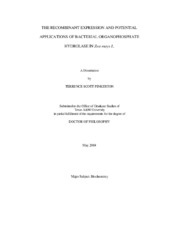| dc.contributor.advisor | Wild, James R. | |
| dc.creator | Pinkerton, Terrence Scott | |
| dc.date.accessioned | 2005-08-29T14:35:17Z | |
| dc.date.available | 2005-08-29T14:35:17Z | |
| dc.date.created | 2003-05 | |
| dc.date.issued | 2005-08-29 | |
| dc.identifier.uri | https://hdl.handle.net/1969.1/2194 | |
| dc.description.abstract | Organophosphate hydrolase (OPH, EC 3.1.8.1) is a bacterial enzyme with a broad spectrum of potential substrates that include organophosphorus pesticides, herbicides, and chemical warfare agents. OPH has been expressed successfully in bacterial, fungal, and insect cell culture systems; however, none of these systems produces amounts of enzyme suitable for applications outside of the research laboratory. Therefore, a transgenic Zea mays L. (maize) system was developed to express OPH as an alternate to the current OPH expression systems. The bacterial gene encoding the OPH protein was optimized for transcriptional and translational expression in maize. The optimized gene was inserted into the maize genome under the control of embryo specific, endosperm specific, and constitutive plant promoters. Select transformants were analyzed for the expression of OPH. Expression was observed in the seeds of plants transformed with each of the three constructs with the highest expression observed with the embryo specific and constitutive promoter constructs. The highest OPH expressing lines of transgenic maize had expression levels higher than those reported for the E. coli expression system. OPH was purified from transgenic maize seed and analyzed for posttranslational modification and kinetic properties. OPH was observed to undergo a glycosylation event when expressed in maize that yielded at least two forms of OPH homogolous dimer. The glycosylated form of OPH bound tightly to the Concanavalin A sepharose and remained active after months of storage at room temperature. OPH activity was checked against a number of organophosphate herbicides. Enzymatic activity was observed against the herbicide Amiprophos-methyl and kinetic properties were measured. Enzymatic activity was also tested against the organophosphate Haloxon. Transgenic maize callus, leaf, and seed tissue could be screened for the presence of the optimized opd gene by enzymatic activity. Comparison of the growth of transgenic and control callus on media containing organophosphates showed that the transgenic callus was resistant to the herbicidal effects of haloxon. Transgenic plants expressing OPH were also resistant to the herbicide bensulide when compared to control plants. This indicates that OPH can be used as a screenable marker in plant systems and may be a potential scorable marker system as well. | en |
| dc.format.extent | 1563095 bytes | en |
| dc.format.medium | electronic | en |
| dc.format.mimetype | application/pdf | |
| dc.language.iso | en_US | |
| dc.publisher | Texas A&M University | |
| dc.subject | Plant Biotechnology | en |
| dc.subject | Recombinant Expression | en |
| dc.subject | Organophosphate hydrolase | en |
| dc.subject | Phosphotriesterase | en |
| dc.subject | Herbicides | en |
| dc.subject | Selectable Marker | en |
| dc.subject | Scorable Marker | en |
| dc.title | The recombinant expression and potential applications of bacterial organophosphate hydrolase in Zea mays L. | en |
| dc.type | Book | en |
| dc.type | Thesis | en |
| thesis.degree.department | Biochemistry and Biophysics | en |
| thesis.degree.discipline | Biochemistry | en |
| thesis.degree.grantor | Texas A&M University | en |
| thesis.degree.name | Doctor of Philosophy | en |
| thesis.degree.level | Doctoral | en |
| dc.contributor.committeeMember | Scholtz, J. Martin | |
| dc.contributor.committeeMember | Howard, John A. | |
| dc.contributor.committeeMember | Safe, Stephen | |
| dc.contributor.committeeMember | Park, William | |
| dc.type.genre | Electronic Dissertation | en |
| dc.type.material | text | en |
| dc.format.digitalOrigin | born digital | en |


